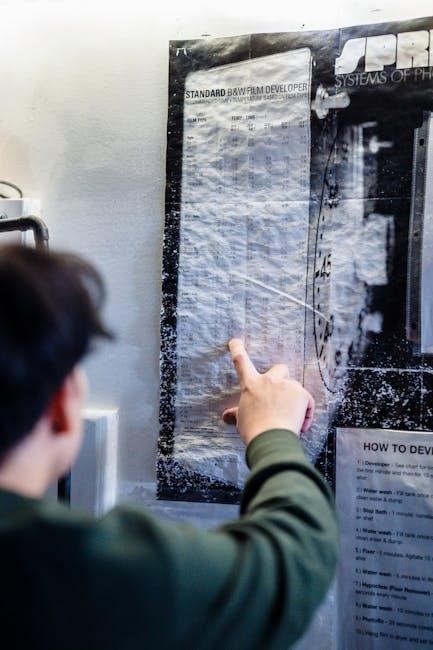
Act 1 sets the tone, introducing Salem’s Puritan community, where fear and guilt simmer. Reverend Parris’s household is in turmoil, with Betty’s mysterious illness and Abigail’s defiance, sparking tensions that unfold the play’s dark themes of accusation and redemption.
The Setting of the Play
The Crucible is set in Salem Village, Massachusetts, in 1692, during the height of the Salem Witch Trials. The play opens in Reverend Samuel Parris’s home, where a tense atmosphere prevails. The setting reflects the Puritan values of the community, emphasizing strict religious beliefs, moral rigor, and a fear of the supernatural. Salem is depicted as a close-knit, isolated society governed by harsh laws and societal expectations. The village’s fear of the unknown and its rigid moral code create an environment ripe for paranoia and accusation. The nearby forest, where the girls danced, symbolizes the forbidden and the unknown, contrasting with the ordered, religious life of the village. This setting establishes the backdrop for the unfolding drama of suspicion and hysteria.
The Initial Conflict Between Reverend Parris and Abigail
The initial conflict between Reverend Parris and Abigail arises from their differing perspectives and motivations. Reverend Parris is deeply concerned about his daughter Betty’s mysterious illness and the potential scandal involving Abigail’s actions in the forest. He questions Abigail about her involvement in the alleged witchcraft, fearing it could damage his reputation and livelihood. Abigail, however, is defiant and unrepentant, showing no remorse for her actions. This tension highlights their strained relationship, with Parris seeking to maintain his authority and Abigail challenging it. Their confrontation sets the stage for the broader conflicts of power, guilt, and accusation that drive the play’s narrative.
An Overview of the Plot in Act 1
Act 1 of The Crucible introduces Salem’s tense atmosphere and the catalysts for the witch trials. The play opens in Reverend Parris’s home, where his daughter Betty lies ill after a mysterious incident in the forest with Abigail and other girls. Parris, fearing scandal, questions Abigail about their activities, revealing her defiance and resentment toward him. The girls’ behavior and Betty’s condition spark rumors of witchcraft, drawing attention from neighbors like the Putnams. John Proctor’s arrival intensifies the conflict, as his past relationship with Abigail and his distrust of Parris create friction. The act concludes with the community’s growing suspicion and fear, setting the stage for accusations and chaos in Act 2.
Key Themes Introduced in Act 1
Act 1 introduces several key themes that resonate throughout the play. The fear of the unknown is evident in Salem’s witchcraft hysteria, as the community seeks scapegoats for unexplained events. Guilt and redemption are explored through John Proctor’s past affair with Abigail and his subsequent moral struggles. The destructive power of unchecked ambition is seen in Abigail’s manipulation of others to eliminate Elizabeth Proctor. Additionally, the theme of reputation versus reality is highlighted, as characters like Parris and the Putnams prioritize social standing over truth. These themes set the foundation for the play’s exploration of human frailty and societal madness.

Character Analysis
Act 1 introduces key characters whose actions and motivations drive the plot. Reverend Parris is a self-serving, paranoid leader, obsessed with his reputation. Abigail, his niece, is cunning and vengeful, harboring a grudge against Elizabeth Proctor. Betty Parris, Reverend Parris’s daughter, is fragile and emotionally unstable. John Proctor, a farmer, enters with a sense of integrity but also guilt over his past affair with Abigail. Giles Corey and the Putnams represent the community’s superstition and greed, fueling the witchcraft hysteria. These characters’ flaws and conflicts set the stage for the tragic events that unfold.
Reverend Parris: His Role and Motivations
Reverend Parris is a self-serving and manipulative figure whose primary concern is maintaining his reputation and authority. He is driven by fear of public shame and a desire to protect his status, as seen when he calls for a doctor to examine Betty, fearing accusations of witchcraft. Parris questions Abigail about her actions in the woods, not out of genuine concern for his daughter but to shield himself from potential scandal. His motivations are rooted in self-preservation and a need to control those around him, revealing a man more focused on appearances than truth or morality. His paranoia and rigid adherence to societal expectations set the stage for the conflict that unfolds.
Abigail Williams: Her Relationship with the Proctors
Abigail Williams, once a servant in the Proctor household, harbors deep resentment and jealousy toward Elizabeth Proctor. Her dismissal from the Proctors’ employment, due to her affair with John Proctor, fuels her animosity. Abigail’s feelings for John remain unresolved, creating tension between her and Elizabeth, whom she blames for her downfall. Her motivations are driven by a desire for revenge and a need to reclaim John’s affection, even if it means destroying Elizabeth’s reputation. This complex dynamic sets the stage for Abigail’s manipulative behavior and her role in the witch trials, as she seeks to eliminate Elizabeth and regain John’s love through deceit and accusation.
Betty Parris: Her Condition and Its Implications
Betty Parris, Reverend Parris’s daughter, falls into a mysterious, unresponsive state, sparking fear and speculation in Salem. Her condition arises after she, Abigail, and Tituba engage in forbidden rituals in the forest. Betty’s inability to awaken and her subsequent trance-like state create panic, as the community attributes her illness to supernatural forces. This event escalates tensions, leading to accusations of witchcraft and setting the stage for the trials. Betty’s condition not only highlights the fragility of her father’s household but also serves as the catalyst for the hysteria that engulfs Salem, drawing attention to the vulnerabilities of the Puritan community and its tendency to seek scapegoats for unexplained phenomena.
John Proctor: His Entrance and Character Description
John Proctor, a respected Salem farmer, enters Act 1 as a man of moral integrity but also with a flawed past. His affair with Abigail Williams creates underlying tension, as she harbors unrequited feelings for him. Proctor’s decision to end the affair and remain committed to his wife, Elizabeth, showcases his sense of duty and conscience. However, his past sin makes him vulnerable to Abigail’s revenge, which later fuels the witch trials. Proctor’s character is defined by his struggle for redemption and his eventual stand against the hysteria, highlighting his complexities as a tragic figure in the play.

Giles Corey and the Putnams: Their Involvement in the Conflict
Giles Corey, a stubborn and aging farmer, enters Act 1 with a reputation for disputes over land ownership, showcasing his fiery temperament. His skepticism of the church and its authority creates tension, as he challenges the community’s rigid beliefs. Meanwhile, the Putnams, particularly Thomas, are driven by a desire for power and revenge. They use the witchcraft hysteria to eliminate rivals and gain control over land, exploiting the fear gripping Salem. Their involvement deepens the conflict, as they manipulate accusations to serve their own interests, further fueling the chaos and paranoia that spreads throughout the community.

Study Questions for Act 1
Questions explore themes of guilt, fear, and accusation, prompting analysis of character interactions, plot development, and the societal tensions driving Salem’s witchcraft hysteria.
Factual Recall Questions
Why has Reverend Parris sent for a doctor at the beginning of the play?
What unusual activities were Betty and Abigail engaged in the night before the play starts?
What does Tituba reveal about the events in the forest?
Why is John Proctor’s relationship with Abigail significant?
What does the arrival of Reverend Hale signify?
How does the community react to Betty’s condition?
What does Parris accuse Abigail of doing?
Why do the Putnams suspect witchcraft?
What is the state of Salem’s social dynamics as depicted in Act 1?
How does Proctor describe his relationship with Abigail?
These questions test understanding of key events, character motivations, and societal tensions in Act 1.
Higher-Order Thinking Questions
How does the fear of the unknown contribute to the escalation of events in Salem?
What motivates Abigail Williams to accuse others, and how does her past influence her actions?
How does the Puritan value system exacerbate the conflict in Act 1?
What does Reverend Parris’s prioritization of his reputation reveal about his character?
How does the community’s collective guilt shape their reactions to Betty’s condition?
In what ways does John Proctor’s moral stance clash with the societal norms of Salem?
What role does hysteria play in the dynamics between the characters?
How does Miller use the opening act to foreshadow the tragic events of the play?
What does Tituba’s confession reveal about the societal pressures faced by marginalized groups?
How does the pursuit of power and control drive the characters’ decisions?
These questions encourage analysis of themes, motivations, and societal influences in Act 1.
Character-Specific Questions
What motivates Reverend Parris to send for a doctor, and how does this reveal his priorities?
How does Abigail Williams’s relationship with John and Elizabeth Proctor influence her actions?
What does Betty Parris’s condition suggest about the emotional and psychological state of the community?
How does John Proctor’s entrance in Act 1 establish his character and moral stance?
What role does Tituba play in the unfolding events, and how does her status as a slave affect her actions?
How do the Putnams’ desires and grievances drive their behavior in the play?
What does Giles Corey’s skepticism reveal about his character and the community’s mindset?
How does Abigail manipulate others to achieve her goals?
What does Reverend Parris’s treatment of Abigail indicate about their relationship?
How does Elizabeth Proctor’s absence in Act 1 impact the dynamics between the characters?
These questions focus on understanding the characters’ roles and motivations in Act 1.

Theme-Based Questions
How does fear of the unknown contribute to the tension in Act 1?
In what ways does guilt manifest in the characters’ actions and dialogue?
How does the theme of redemption emerge through John Proctor’s character?
What role does the fear of witchcraft play in controlling the community?
How does the theme of power dynamics influence Reverend Parris’s interactions with others?
What does the play suggest about the consequences of unchecked ambition?
How does the theme of reputation shape the decisions of characters like Proctor and Abigail?
In what ways does the play explore the tension between individual conscience and societal expectations?
How does the theme of betrayal surface in Act 1, particularly through Abigail’s actions?
What does the play indicate about the destructive nature of secrets and lies?
These questions encourage exploration of the themes that drive the plot and character development in Act 1.
Plot Development Questions
How does Betty Parris’s illness initially drive the plot and create tension?
What role does Abigail’s accusation of witchcraft play in advancing the story?
How does John Proctor’s entrance in Act 1 foreshadow future conflicts?
What significance does the discovery of the girls dancing in the forest hold?
How does Reverend Parris’s concern for his reputation influence his actions?
In what ways does the Putnams’ suspicion of witchcraft escalate the plot?
How does the doctor’s inability to diagnose Betty’s condition heighten the mystery?
What impact does the arrival of John Hale have on the unfolding events?
How does Abigail’s confrontation with Parris reveal underlying motivations?
What clues in Act 1 suggest the broader societal fears that will fuel the witch trials?
These questions help trace how the events of Act 1 lay the groundwork for the play’s dramatic progression.

Literary Devices in Act 1

Miller uses dialogue to reveal character motivations and conflicts, while stage directions set a tense atmosphere. Symbolism, like the forest, represents forbidden desires, and irony underscores the community’s hypocrisies, foreshadowing tragic events.
Dialogue Analysis: Key Conversations
The dialogue in Act 1 reveals critical character motivations and escalating tensions. Reverend Parris’s interrogation of Abigail exposes his fear of scandal and her defiant nature. The Putnams’ discussion of witchcraft highlights their suspicion and societal fear. Abigail’s threat to Parris underscores her determination to protect herself. Proctor’s entrance sparks tension, as his interaction with Abigail hints at their past affair. These conversations drive the plot, showcasing themes of guilt, accusation, and redemption. Miller’s use of sharp, emotional exchanges underscores Salem’s oppressive atmosphere, while foreshadowing the tragic events to come. The dialogues also highlight the characters’ moral complexities and the community’s readiness to blame others for its problems.
Stage Directions and Their Significance
The stage directions in Act 1 of The Crucible are crucial in setting the tone and atmosphere of the play. The opening scene in Reverend Parris’s dimly lit room creates an eerie, tense environment, reflecting the fear and guilt that permeate Salem. The description of Betty lying motionless on the bed immediately grabs attention, signaling that something is gravely wrong. The stage directions also emphasize the characters’ emotions and interactions, such as Abigail’s confident stance and Proctor’s awkward entrance, which hint at underlying tensions. Miller’s use of physical movement, like Abigail and Proctor’s private exchange, underscores their complex relationship. These directions not only guide the actors but also help the audience interpret the characters’ motivations and the unfolding drama.
Symbolism in Act 1
Symbolism in Act 1 of The Crucible enriches the narrative, with elements like the forest and Betty’s condition holding deeper meanings. The forest, where the girls danced, symbolizes rebellion and the unknown, contrasting with Salem’s rigid Puritan values. Betty’s unexplained illness represents the fear of the supernatural and the community’s vulnerability to hysteria. The candle in Parris’s room signifies truth and clarity, yet its dim light reflects the obscurity of reality amidst fear. These symbols foreshadow the chaos and moral ambiguity that will unfold, highlighting themes of guilt, redemption, and societal fear. Miller uses these elements to create a layered narrative that engages both the characters and the audience in the unfolding drama.
Irony and Foreshadowing
Act 1 of The Crucible is rich in irony and foreshadowing, setting the stage for the tragic events to come. The irony lies in Reverend Parris’s concern for his reputation over his daughter’s well-being, as his fears of scandal ultimately lead to the very downfall he dreads. Foreshadowing is evident when Abigail mentions the gathering crowd, hinting at the communal hysteria that will soon engulf Salem. Additionally, the mention of Betty’s claim of seeing something in the woods subtly prepares the audience for the supernatural accusations that will dominate the play. These elements create tension and highlight the impending chaos, drawing the audience into the unfolding drama and underscoring the themes of fear, guilt, and societal collapse.

Historical Context
The Salem Witch Trials of 1692-1693 inspired The Crucible. Miller reflects the hysteria, paranoia, and societal fears of that period, using it to critique McCarthyism. Religion’s influence on the trials is central, showcasing how fear drove accusations and executions, mirroring the Red Scare’s political climate.

The Salem Witch Trials: A Brief Background
The Salem Witch Trials occurred in 1692-1693 in colonial Massachusetts, leading to the execution of 20 people accused of witchcraft. Driven by fear, paranoia, and religious zeal, the trials began with young girls claiming supernatural affliction. The accusations spiraled, targeting marginalized individuals. Arthur Miller’s The Crucible mirrors this hysteria, using it to critique McCarthyism. Act 1 reflects the historical context by depicting a society prone to fear and false accusations, emphasizing themes of guilt, redemption, and societal manipulation. The trials highlight how fear and superstition can destabilize communities, aligning with Miller’s exploration of human frailty and moral failure.
How Act 1 Reflects Historical Events
Act 1 mirrors the Salem Witch Trials’ onset, capturing the communal fear and paranoia that fueled the hysteria. The mysterious illness of Betty Parris and the accusations of witchcraft by Abigail Williams echo the historical events where young girls’ accusations led to mass panic. The character of Reverend Parris reflects the societal pressure to conform, while the inclusion of Tituba, a slave, highlights the vulnerability of marginalized individuals. The play’s depiction of neighbors turning against each other and the focus on supernatural explanations for unexplained events align with historical records. Miller’s portrayal of these elements underscores the dangers of unchecked fear and false accusations, drawing a direct parallel to the historical context.
The Role of Religion in Salem Society
Religion dominates Salem’s rigid, theocratic society, shaping laws, social norms, and daily life. The Puritan faith emphasizes God’s judgment, fostering a culture of fear and guilt. Reverend Parris, as a spiritual leader, wields significant authority, yet his own insecurities and fear of losing respect drive his actions. The community’s belief in the supernatural and divine retribution creates a climate where unexplained events, like Betty’s illness, are quickly attributed to witchcraft. This religious fervor fuels accusations, as individuals like the Putnams seize on spiritual explanations to justify their fears. The play highlights how religion, while central to the community, also becomes a tool for control and manipulation, exacerbating the mounting tension and hysteria.
Act 1 introduces Salem’s tense atmosphere, with Reverend Parris’s household at its center. Betty’s illness and Abigail’s accusations ignite fear and suspicion, revealing underlying conflicts and themes of guilt, power, and hysteria that drive the play’s unfolding drama.

Major Events of Act 1
Act 1 opens with Reverend Parris discovering his daughter Betty and niece Abigail in a trance-like state after dancing in the woods, sparking fears of witchcraft. The doctor’s inability to diagnose Betty’s illness escalates tensions. Abigail’s confrontation with Parris reveals her resentment towards him and her past affair with John Proctor. Meanwhile, the arrival of John Hale, a witchcraft expert, intensifies the community’s fear. Giles Corey and the Putnams discuss land disputes and witchcraft suspicions, foreshadowing the trials. Proctor’s entrance highlights his strained relationship with Abigail and his suspicion of her intentions. The act concludes with Abigail’s accusations against Tituba, setting the stage for the witch hunt.
Character Relationships and Conflicts
In Act 1, Reverend Parris’s protective yet fearful nature clashes with Abigail’s defiance, revealing underlying tensions. Abigail’s resentment toward Parris stems from his disapproval of her actions. John Proctor’s past affair with Abigail creates friction, as Elizabeth Proctor’s distrust of Abigail grows. The Putnams’ grief over their dead children fuels their suspicion of witchcraft, while Giles Corey’s skepticism of the court and land disputes with the Putnams escalate tensions. Betty’s illness becomes a focal point of fear and accusation, highlighting the fragile relationships within the community. These conflicts set the stage for the escalating accusations and betrayals that drive the play’s tragic momentum.
Themes and Their Development
In Act 1, Arthur Miller introduces themes of fear, guilt, and redemption. The fear of the unknown, manifested through Betty’s illness, spreads panic and suspicion. Guilt emerges as Abigail, haunted by her past with John Proctor, seeks redemption through manipulation. The theme of revenge is evident in Abigail’s motives against Elizabeth. The oppressive nature of Puritan society is also highlighted, as strict moral codes suppress individuality. These themes are intertwined with the communal hysteria, setting the stage for the destructive consequences of unchecked fear and vengeance. The act lays the groundwork for exploring how these themes escalate the witch trials, exposing the dark underbelly of Salem’s society.
Preparation for Act 2
Act 1 lays the groundwork for the escalating tensions in Act 2. The seeds of suspicion and accusation sown in Act 1—such as Abigail’s vendetta against Elizabeth and the communal fear of witchcraft—begin to germinate. John Proctor’s past affair with Abigail and his strained relationship with Elizabeth create emotional turmoil that intensifies in Act 2. The introduction of Reverend Hale, an expert in witchcraft, signals the arrival of external authority, heightening the stakes. Themes of guilt, redemption, and the dangers of unchecked power emerge, setting the stage for the trials. Act 1’s focus on individual conflicts and societal hysteria prepares the audience for the broader societal collapse and moral dilemmas that dominate Act 2.
